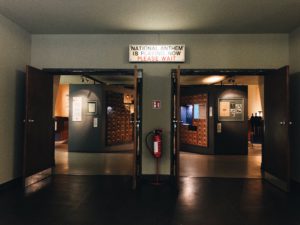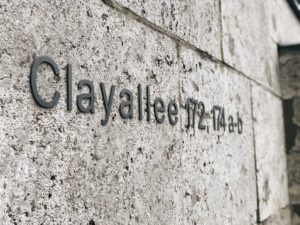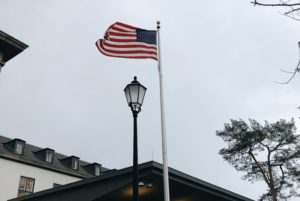
(Re)allocation: make Berlin great again – the museum of the Allies
ZEHLENDORF – During the occupation of Berlin at the Cold War, American soldiers played an important role. They took care of the liberation of the city. Since nobody knew how long the Cold War would last, Little America arose in the district of Zehlendorf.
Today in Zehlendorf you can visit the museum of the Allies. Yet this building has a very different history. If you go back fifty years, you’ll find a cinema here called Outpost. Here the American soldiers could relax and enjoy a movie. You could only pay in dollars and the films were imported directly from Hollywood. Furthermore, the cinema was reserved for Americans and as a German you could only enter by invitation. Besides playing films, the hall was also used for other activities. For example, there were proclamations of the secondary school and you could also enjoy a play from time to time.
‘They gave me the keys and wished me a good day’
Barely a day after the last movie, Florian Weis was entrusted with the keys to the cinema. The popcorn machines were picked up, tickets were thrown away and the projector was put away. After cleaning up the entire place, Florian transformed the old cinema into a memorial for the Allies in Berlin and became a museum owner. In the museum you will find a lot of information about the airlift. During the first period of the Cold War, the Americans provided food supplies over the airlift in Tempelhof. At the moment there are plans to move the museum to Tempelhof.

The building was designated a heritage site, which means that many aspects of the hall have remained unchanged. With a little imagination, you can find yourself in a cinema from the sixties. There are still the same doors as back then and the stage is still completely intact.
Clayallee 170: former American headquarter

The German Luftwaffe
The Nazis left us many traces after the Second World War thanks to the giant structures and buildings they’ve established. The Clay Headquarters is one of them. In fact, it’s one of the biggest buildings the Nazis built. On july 4th, 1945, the American troops occupied South Berlin. They immediately installed their headquarters in the former headquarters of the German Luftwaffe, in Berlin-Zehlendorf. It was built between 1935 and 1937 and counts no less than 85.000 m². Luckily, the buildings were only lightly damaged by the bombings during the war.
The Berlin Blockade
After World War II, Berlin was divided into four areas. Each area was controlled by one of the victorious Allied countries: the French, the English, the Americans and the Soviets. In 1948, the Soviets introduced an important measure. All military and passenger traffic between American, British and French occupation zones and Berlin was banned. On top of that, no cargo could leave Berlin by train without the consent of a Soviet Commander. The next day, General Clay immediately ordered all military trains to stop. From that moment, all supplies to the military garrison had to be transported by air. The Berlin blockade was a turning point in the Soviet occupation. In their attempt to take full control over Berlin, they believed it was best to starve the Berliners in order to force the Western Allies to withdraw from Berlin. The effect was quite the opposite. In response, the Allies began the Berlin Airlift. An attempt to supply the city by aircraft, instead of road and rail access. Many thought it was impossible, due to the limited cargo capacity of the planes. The city needed as much as 2 tons of food a day. But, against all odds, it succeeded. For 324 days, thousands of planes left Tempelhof Airport and supplied the city. Until eventually the Soviets had to give up and lift the blockade. The leader of this huge operation was the military governor in Berlin called Lucius D. Clay. To honour him, the name of the street that houses the headquarters, was changed from Kronprinzenallee to Clayallee.
The Cold War
The end of the airlift in 1949 marked the beginning of the Cold War as we know it. By 1950 the mission of the American Army troops totally changed. The goal was no longer to occupy Berlin but rather to protect it from the Soviet threat. At that point, Clayallee 170 became the Headquarters of the Berlin Supreme Command and later also the American-Berlin Army Headquarters. When L. Clay died in 1979, 30 years after the airlift, the building was renamed General Lucius D. Clay headquarters. When the Americans left Berlin in 1994, the American consulate remained in the building.

Residences and the U.S. Citizen Service
When you’re in the Clayallee today, there’s no clue to the past. A place that was once so crucial for Western-Europe, has now been transformed into apartments. German kids are carelessly riding their bikes, not having a clue about all the millions of American kids that used to live in the neighbourhood. The main part of the building is now the U.S. citizen service. The people entering the building to get their visa, are now walking under the same American flag as millions of soldiers used to. A building with an important history, on a street carrying the name of a remarkable man: Lucius D. Clay.
Want to start exploring Zehlendorf yourself? We’ve created a route that’ll take you to some very nice spots.
Text, audio and photos: © Heleen Dehollogne en Yoni Van den Dycke



